LG Bundle
Who Buys LG Products?
From its humble beginnings in South Korea to its current global dominance, LG's journey is a testament to understanding its customers. The company's 'Optimism Your Feed' campaign highlights the importance of knowing its audience. This deep dive explores the evolution of LG's customer base, its geographical reach, and how it strategically acquires and retains customers.
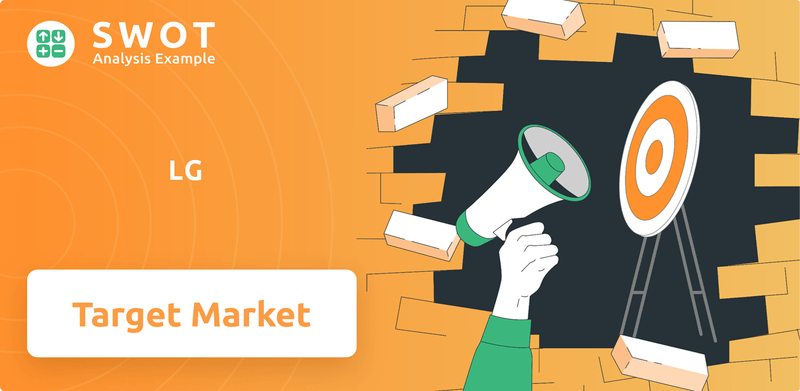
Understanding the customer demographics LG targets is crucial for its success. This analysis unveils the LG target market and how the company tailors its offerings to meet their needs. We'll explore the LG company analysis through the lens of its consumer profile, market segmentation, and audience research, offering insights into LG's strategies for reaching its ideal customer.
Who Are LG’s Main Customers?
Understanding the customer demographics and target market is crucial for the success of any business, and LG is no exception. LG Corporation strategically segments its customer base into Business-to-Consumer (B2C) and Business-to-Business (B2B) categories. This approach allows for tailored marketing and product development, ensuring that LG meets the diverse needs of its varied customer segments. The company's ability to adapt to these segments is a key factor in its sustained market presence.
The B2C segment primarily includes individual consumers and households. These customers are interested in home entertainment systems, home appliances, and personal electronics. This segment is further broken down by age, income, education, and family status. LG's product offerings, such as premium OLED TVs and high-end appliances, target affluent households, while more budget-friendly options cater to middle-income consumers. This tiered approach allows LG to capture a broad customer base.
In the B2B segment, LG focuses on industries like hospitality, healthcare, education, and automotive. This involves providing commercial displays, HVAC systems, vehicle components, and IT solutions. This segment is characterized by large corporations, small and medium-sized enterprises (SMEs), and government entities. Purchasing decisions in this segment are often driven by cost-efficiency, scalability, reliability, and technological advancement. LG's strategic shift towards higher-margin businesses, including premium home appliances and B2B solutions, reflects the growing demand for integrated and smart technologies in both consumer and commercial settings. Competitors Landscape of LG provides a comparative view of LG's market positioning.
LG's customer demographics vary significantly across its product lines. For instance, millennials and Gen Z are key targets for smartphones and portable electronics. For home appliances and televisions, the age range is broader. Income levels also play a crucial role, with premium products aimed at affluent consumers and budget-friendly options for middle-income households. Education and occupation often correlate with technology adoption rates, with professionals and tech-savvy individuals showing higher engagement.
The B2B segment includes large corporations, SMEs, and government entities. Purchasing decisions are driven by factors such as cost-efficiency, scalability, reliability, and technological advancement. LG's focus on this segment has led to significant growth, especially in vehicle component solutions. For example, sales in Q4 2023 reached 2.65 trillion won (approximately 2 billion USD), indicating a strong presence in the automotive sector.
LG employs various market segmentation strategies to reach its diverse customer base. This includes geographic segmentation, with tailored products for different regions. Demographic segmentation is used to target specific age groups, income levels, and family structures. Psychographic segmentation considers lifestyles and values, while behavioral segmentation focuses on product usage and brand loyalty. These strategies enable LG to customize its marketing efforts and product offerings to meet the specific needs of each segment.
Product preferences vary significantly across demographic groups. Younger consumers often prioritize smartphones and portable electronics, while older demographics focus on home appliances and televisions. Income levels influence the choice of product tiers, with higher-income consumers opting for premium models. Family status also plays a role, with families often prioritizing larger capacity appliances and entertainment systems. LG's diverse product portfolio caters to these varied preferences.
LG's primary customer segments are B2C (households and individual consumers) and B2B (various industries). The B2C segment is segmented by age, income, and lifestyle. The B2B segment includes large corporations, SMEs, and government entities. LG’s strategic shift towards higher-margin businesses, including premium home appliances and B2B solutions, reflects the increasing demand for integrated and smart technologies.
- Age: Millennials and Gen Z are key targets for smartphones and portable electronics.
- Income: Premium products target affluent households, while budget-friendly options cater to middle-income consumers.
- B2B Growth: LG's vehicle component solutions business saw sales of 2.65 trillion won (approximately 2 billion USD) in Q4 2023.
- Market Focus: LG is focusing on premium home appliances and B2B solutions due to the increasing demand for integrated and smart technologies.
LG SWOT Analysis
- Complete SWOT Breakdown
- Fully Customizable
- Editable in Excel & Word
- Professional Formatting
- Investor-Ready Format
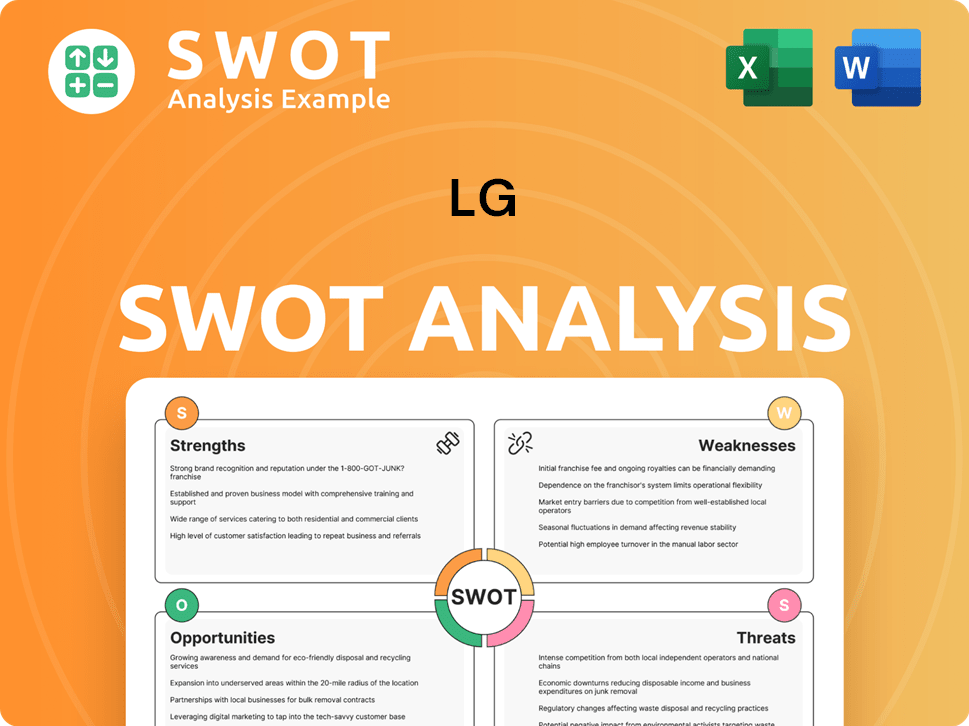
What Do LG’s Customers Want?
Understanding customer needs and preferences is crucial for the success of any company, including the [Company Name]. Customers are driven by a mix of practical, psychological, and aspirational needs. This insight allows the company to tailor its products and marketing strategies effectively.
In the competitive landscape of consumer electronics and home appliances, these needs significantly influence purchasing decisions and brand loyalty. The company's approach to product development, marketing, and customer service is deeply rooted in understanding and meeting these diverse customer expectations. This customer-centric approach helps the company maintain a competitive edge.
The company's customer base is diverse, spanning various demographics and preferences. Factors such as energy efficiency, ease of use, and innovative features are key drivers for customers. The company's ability to address these needs, along with its commitment to design and sustainability, shapes its market position.
Customers prioritize energy efficiency, durability, and ease of use in home appliances. The company's focus on AI-powered features in products like washing machines and refrigerators caters to these needs. Decision-making involves balancing price, features, brand reputation, and after-sales service.
Consumers seek products that offer comfort, convenience, and a sense of modernity. The company's sleek and minimalist design aesthetic caters to aspirational needs. Positive past experiences, reliable customer support, and value for money drive brand loyalty.
The company addresses customer pain points such as the desire for quieter appliances, more intuitive interfaces, and longer product lifespans. Customer feedback and market trends significantly influence product development. The company strives to improve product quality and user experience.
The company tailors its marketing to specific segments. Campaigns for premium OLED TVs emphasize immersive viewing experiences, appealing to enthusiasts. Campaigns for basic home appliances focus on reliability and practicality for a broader audience. The company's marketing strategies are data-driven.
The company's commitment to sustainability resonates with environmentally conscious consumers. Energy-efficient models influence purchasing decisions. The company is investing in sustainable practices to meet customer demands.
The demand for smart home connectivity is a key driver for the company's smart appliance sales. The company continually introduces innovative technologies to simplify daily tasks and enhance living spaces. The company focuses on technological advancement.
The company's customer base is diverse, and understanding their needs is essential for success. The company's market share in the global consumer electronics market was approximately 10.3% in 2024, according to Statista. The company's revenue in 2024 was approximately $66.8 billion. The company's focus on innovation and customer satisfaction has helped it maintain a strong position in the market. To learn more about the company's history, you can read a Brief History of LG.
The company's customer base is driven by a combination of practical, psychological, and aspirational needs, influencing their purchasing behaviors and brand loyalty. These preferences shape the company's product development and marketing strategies.
- Energy Efficiency: Customers increasingly prioritize energy-efficient appliances, driven by both cost savings and environmental concerns.
- Smart Home Integration: The demand for smart home connectivity and seamless integration of devices is a key driver for sales.
- Design and Aesthetics: Sleek, modern designs that enhance living spaces are highly valued by customers.
- Durability and Reliability: Customers seek products that offer long-term performance and reliability.
- Ease of Use: Intuitive user interfaces and user-friendly features are essential for a positive customer experience.
LG PESTLE Analysis
- Covers All 6 PESTLE Categories
- No Research Needed – Save Hours of Work
- Built by Experts, Trusted by Consultants
- Instant Download, Ready to Use
- 100% Editable, Fully Customizable
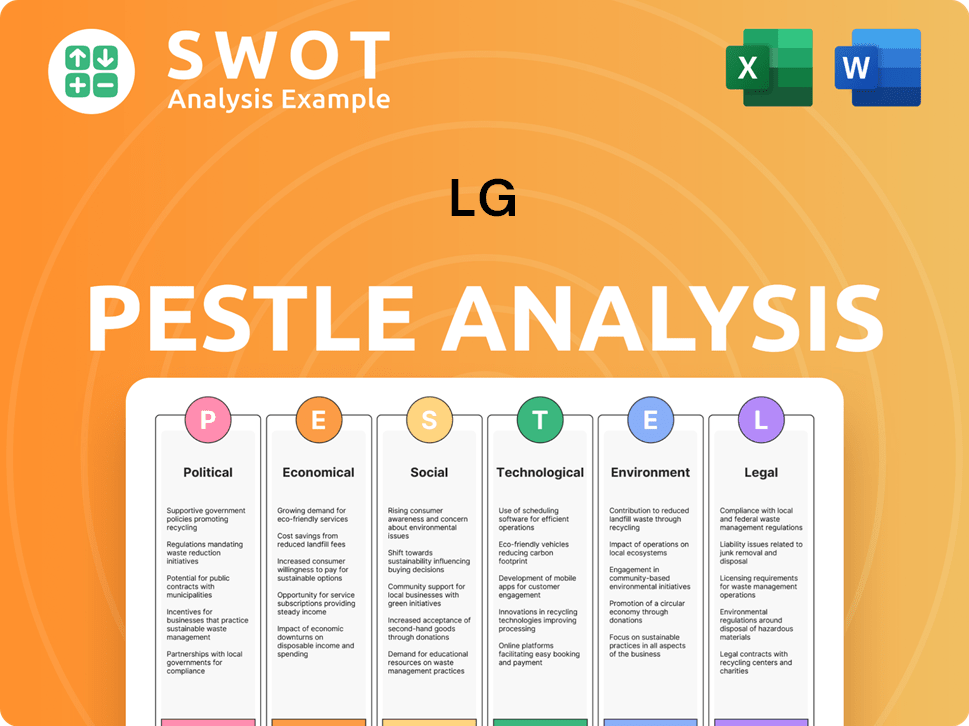
Where does LG operate?
The geographical market presence of LG is a crucial element of its global success. The company has established a strong foothold across various continents, tailoring its strategies to meet the diverse needs and preferences of consumers in different regions. This approach allows LG to maintain a competitive edge and drive growth in both mature and emerging markets.
LG's major markets include North America, Europe, Asia, and Latin America. Each region presents unique opportunities and challenges, requiring LG to adopt localized strategies. This includes adapting product features, marketing campaigns, and distribution channels to suit regional tastes and economic conditions. The company's ability to navigate these complexities is a key factor in its sustained global success.
LG's global strategy involves a mix of premium product offerings in developed markets and more accessible models in emerging economies. This dual approach allows LG to maximize its market share and revenue streams. Furthermore, LG continuously evaluates its portfolio, as seen by its strategic withdrawal from the mobile phone business in 2021, to focus on high-growth sectors.
In North America, LG holds a strong market position, particularly in home appliances and televisions. Consumers in this region often prioritize smart features, energy efficiency, and design. The US market is a key driver for LG's premium appliance sales. LG focuses on innovation and high-end products to cater to the demands of the North American consumer base.
LG adapts to diverse consumer preferences in Europe, with a focus on energy-saving technologies and localized content for its smart TVs. The company faces strong competition in the European market, requiring it to stay innovative and competitive. LG's success in Europe depends on its ability to align with local regulations and consumer trends.
Asia remains a critical region for LG, with South Korea serving as its home market and a hub for research and development. China represents a massive market with evolving consumer demands, while India is a rapidly growing market for home appliances and consumer electronics. LG localizes its offerings by adapting product features, marketing campaigns, and distribution channels to suit regional tastes and economic conditions.
In Latin America, LG focuses on affordability and accessibility while still offering innovative products. Recent expansions have seen LG strengthen its B2B presence in emerging markets, recognizing the growing demand for commercial solutions. LG's strategic approach in Latin America involves balancing innovation with cost-effectiveness to capture market share.
LG's market penetration strategy involves a mix of premium product offerings in developed markets and more accessible models in emerging economies. This dual approach allows LG to maximize its market share and revenue streams. For example, in India, LG has focused on expanding its distribution network to reach a wider customer base.
LG localizes its offerings by adapting product features, marketing campaigns, and distribution channels to suit regional tastes and economic conditions. For instance, certain appliance models might be designed to accommodate specific cultural cooking habits or living space constraints in Asian markets. This approach enhances customer satisfaction and brand loyalty.
Strategic withdrawals, such as the exit from the mobile phone business in 2021, reflect a strategic reallocation of resources to more profitable and high-growth sectors. This allows LG to focus on areas where it can achieve higher returns on investment. The company's focus on OLED TVs is a prime example of this strategy.
LG has been strengthening its B2B presence in emerging markets, recognizing the growing demand for commercial solutions. This includes offering products and services tailored to business needs. This expansion helps diversify revenue streams and capture new market segments.
The geographic distribution of sales indicates a strong performance in mature markets for premium products, while emerging markets contribute significantly to volume sales of more accessible models. LG's ability to localize its strategies across these diverse regions is a key factor in its sustained global success. For more insights, you can read about Owners & Shareholders of LG.
LG is expected to continue its focus on innovation and sustainability, especially in the areas of energy-efficient appliances and eco-friendly products. The company is likely to invest further in smart home technologies and AI-driven features to meet evolving consumer demands. This forward-looking approach will be essential for maintaining its competitive edge.
LG Business Model Canvas
- Complete 9-Block Business Model Canvas
- Effortlessly Communicate Your Business Strategy
- Investor-Ready BMC Format
- 100% Editable and Customizable
- Clear and Structured Layout
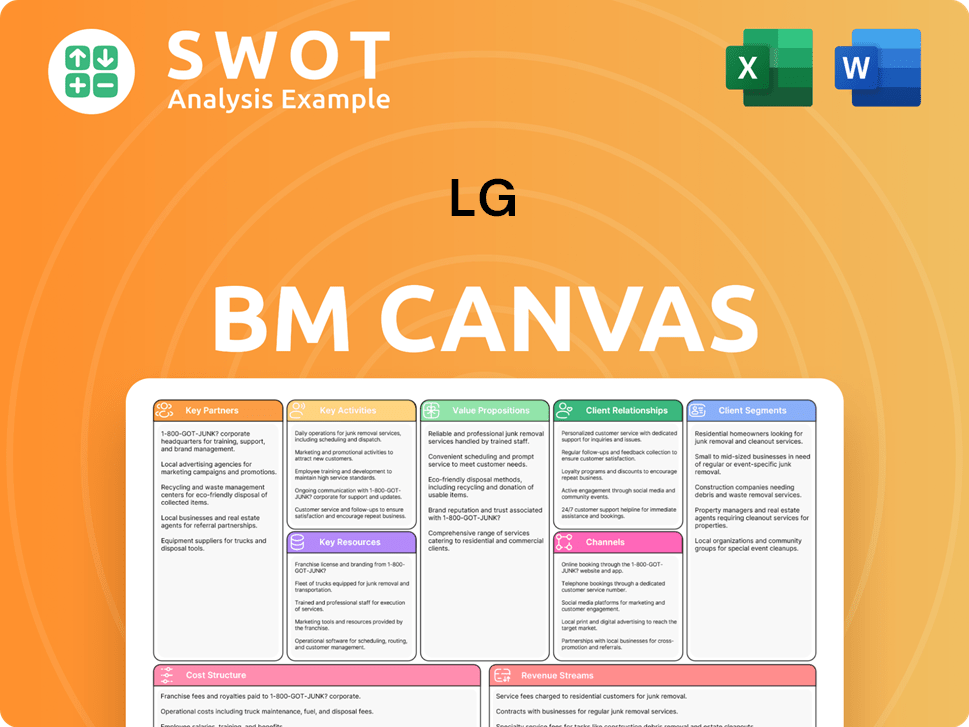
How Does LG Win & Keep Customers?
The company employs a comprehensive strategy for both acquiring and retaining customers. This approach involves a blend of traditional and digital marketing, sales tactics, and initiatives focused on customer satisfaction. Its objective is to build brand loyalty and ensure customer satisfaction post-purchase, which is crucial in a competitive market.
For customer acquisition, the company utilizes extensive advertising campaigns across various platforms. Digital marketing plays a significant role, with investments in social media marketing, search engine optimization (SEO), and targeted online advertisements. Sales tactics include partnerships with major retailers and promotional offers to make products more accessible to a wider audience, which helps to broaden its reach and attract new customers. The company's strategy is designed to increase customer lifetime value and reduce churn rates.
Customer retention strategies focus on building brand loyalty and ensuring post-purchase satisfaction. This includes loyalty programs, extended warranties, and comprehensive after-sales service, such as technical support and repair services. The analysis of customer data and the use of CRM systems are critical for personalizing marketing campaigns and providing tailored customer experiences. These efforts are aimed at enhancing customer relationships and driving long-term growth.
The company invests heavily in advertising across television, print, and digital platforms. Digital marketing includes social media, SEO, and targeted online ads. In 2024, the 'Optimism Your Feed' campaign engaged younger demographics.
Sales strategies involve partnerships with major retailers, promotional offers, and financing options. These tactics make products more accessible and boost sales volume. These strategies are key to capturing a significant portion of the consumer electronics market.
The company offers loyalty programs, extended warranties, and comprehensive after-sales service. These initiatives aim to build brand loyalty and ensure customer satisfaction. These programs help to retain customers and encourage repeat purchases.
The company is increasingly focusing on direct-to-consumer channels and personalized engagement. This shift allows for deeper customer insights and enhanced customer journey. This approach is vital for building strong customer relationships.
The company's approach to customer acquisition and retention is multifaceted, combining traditional advertising with digital strategies and customer-centric initiatives. The company's marketing strategy is designed to reach a broad audience, focusing on innovation and premium features. This comprehensive approach aims to enhance the customer experience and build brand loyalty, ultimately driving long-term growth. For further insights into the company's growth strategies, consider exploring the Growth Strategy of LG.
LG Porter's Five Forces Analysis
- Covers All 5 Competitive Forces in Detail
- Structured for Consultants, Students, and Founders
- 100% Editable in Microsoft Word & Excel
- Instant Digital Download – Use Immediately
- Compatible with Mac & PC – Fully Unlocked
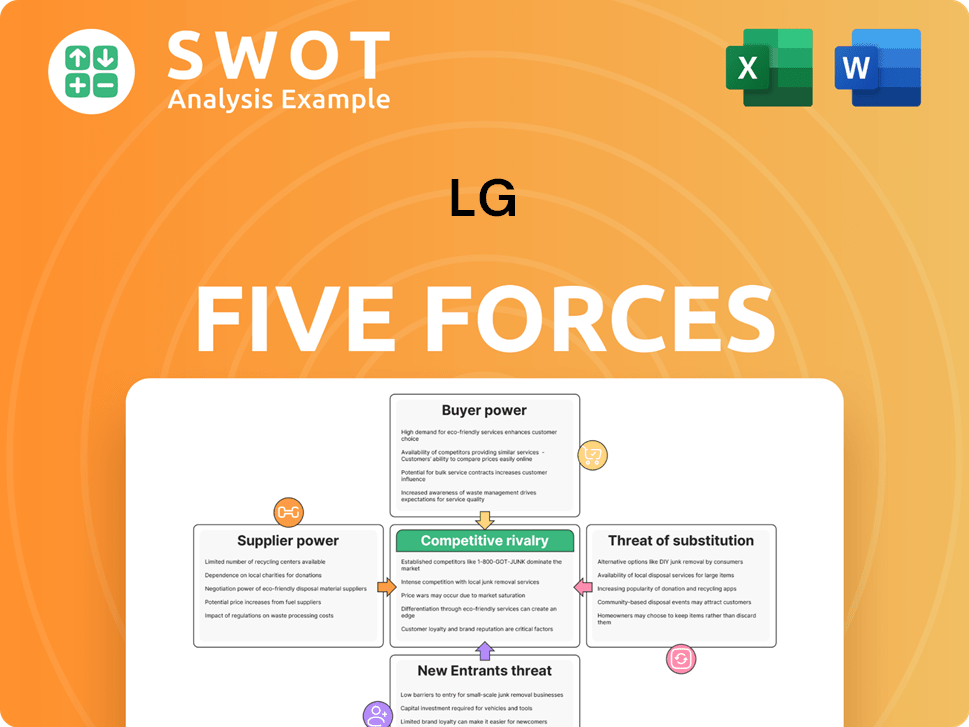
Related Blogs
Disclaimer
All information, articles, and product details provided on this website are for general informational and educational purposes only. We do not claim any ownership over, nor do we intend to infringe upon, any trademarks, copyrights, logos, brand names, or other intellectual property mentioned or depicted on this site. Such intellectual property remains the property of its respective owners, and any references here are made solely for identification or informational purposes, without implying any affiliation, endorsement, or partnership.
We make no representations or warranties, express or implied, regarding the accuracy, completeness, or suitability of any content or products presented. Nothing on this website should be construed as legal, tax, investment, financial, medical, or other professional advice. In addition, no part of this site—including articles or product references—constitutes a solicitation, recommendation, endorsement, advertisement, or offer to buy or sell any securities, franchises, or other financial instruments, particularly in jurisdictions where such activity would be unlawful.
All content is of a general nature and may not address the specific circumstances of any individual or entity. It is not a substitute for professional advice or services. Any actions you take based on the information provided here are strictly at your own risk. You accept full responsibility for any decisions or outcomes arising from your use of this website and agree to release us from any liability in connection with your use of, or reliance upon, the content or products found herein.